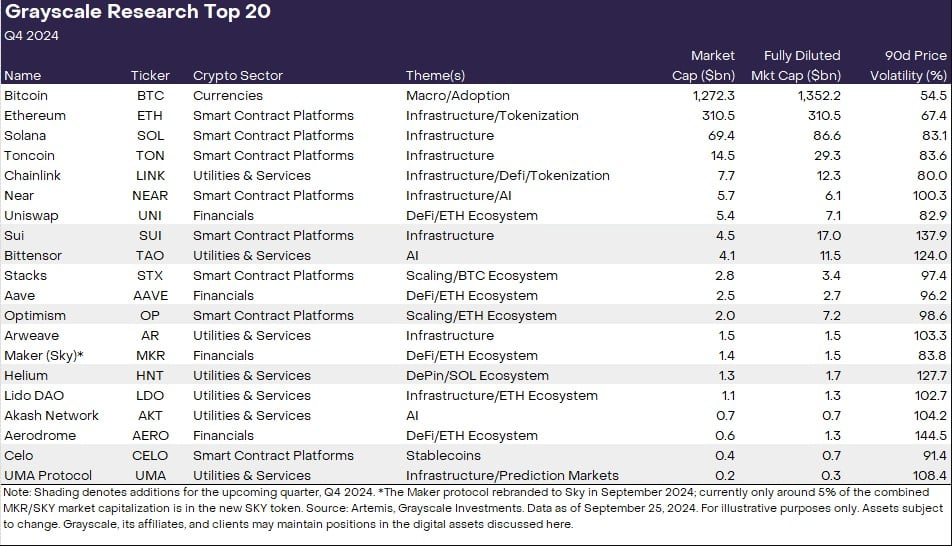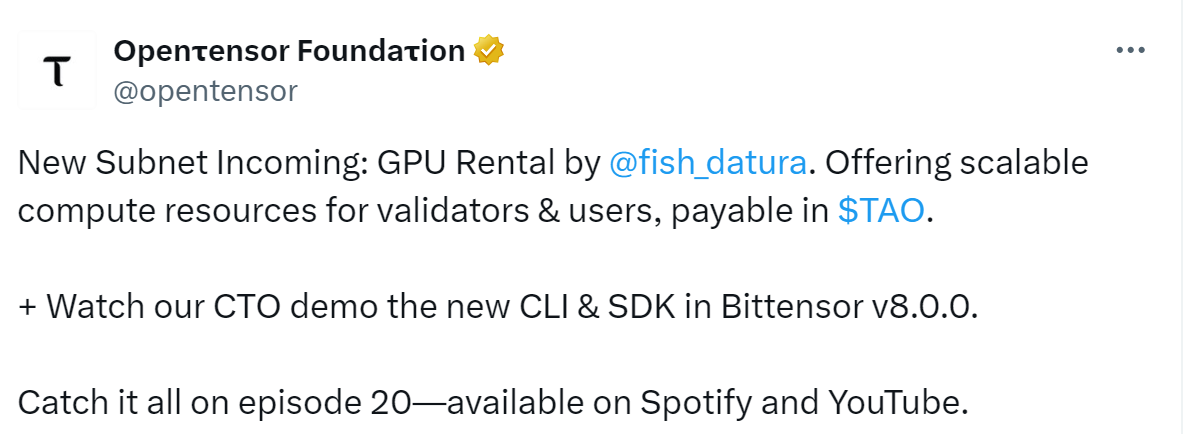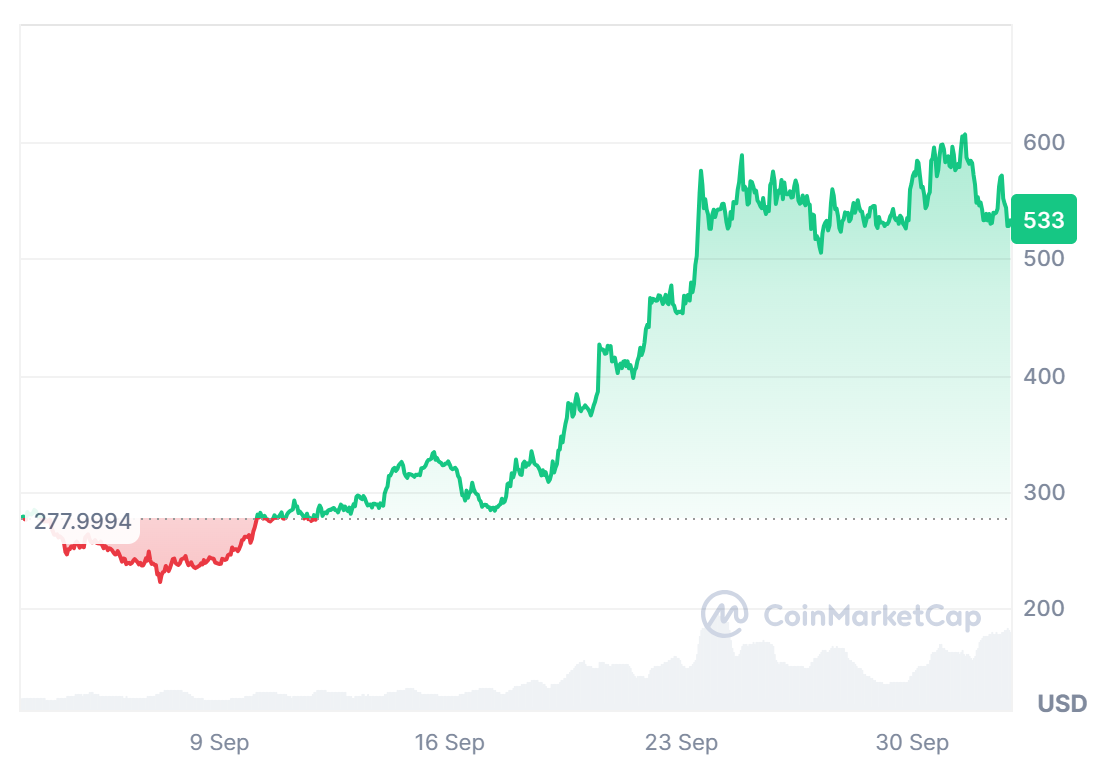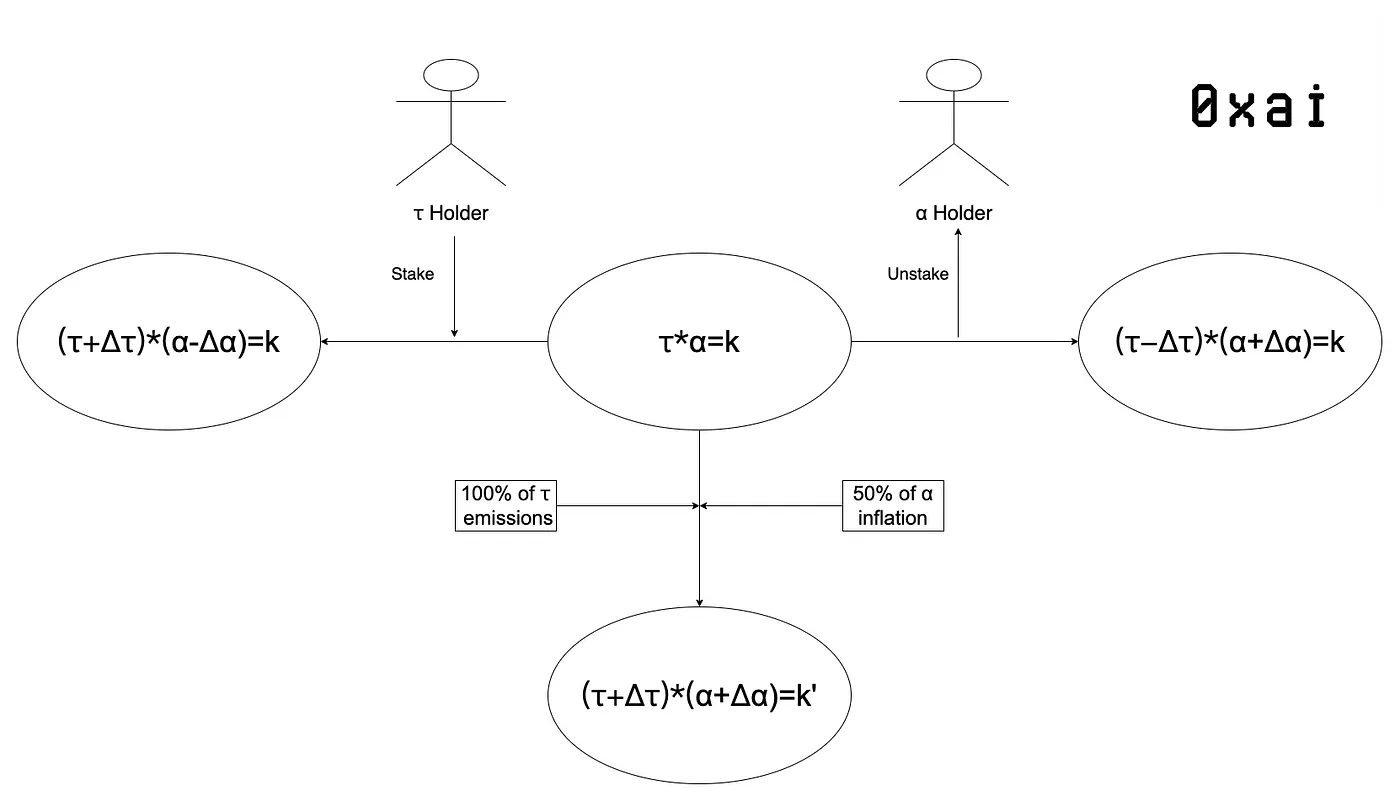Author: Kevin, Caiya researcher from BlockBooster
Recently, Grayscale's research department, Grayscale Research, released a new list of the 20 most promising tokens for Q4 of this year. The list considers various factors such as potential catalysts, network adoption, and risk factors. A total of six new digital assets have been added to the list: Sui (SUI), Optimism (OP), Helium (HNT), Bittensor (TAO), UMA Protocol (UMA), and Celo (CELO). Among them, Bittensor is regarded as an outstanding AI project aimed at combining AI with blockchain to enhance the decentralization of artificial intelligence.

(Source: Grayscale)
On September 28, the TAO Foundation announced that a new subnet is about to launch, providing a GPU leasing platform called Fish, offering scalable computing resources for validators and users, with payments made using TAO tokens. As of the time of writing, the price of $TAO has stabilized around $500.

(Source: Twitter)

(Source: CoinMarketCap)
In addition to Grayscale Research's token potential list and the TAO Foundation's announcements and market performance, what other developments can we expect from Bittensor in the future? Next, we will delve into the operational mechanism of the upcoming subnet token dTAO and analyze its potential impact on the price of $TAO.
dTAO refers to the subnet token, with each subnet having its own dTAO, and the token release aligned with Bitcoin and TAO. After the launch of dTAO, the token will be paired with TAO to form a liquidity pool within the Bittensor network. With the implementation of dTAO, Bittensor will gradually remove the upper limit on subnets, granting the network greater flexibility.
TAO holders can now earn dTAO tokens by staking TAO in different pools. Although this process is referred to as "staking," it is more akin to a swap. The consensus mechanism, token economics, and release speed of dTAO are similar to those of TAO. Each subnet has its own dTAO release, and subnet validators need to purchase/stake dTAO to participate in consensus and earn rewards.
As the market attention on a particular subnet increases, more TAO may be staked in that subnet's pool, thereby increasing its daily TAO release weight in that pool. This dynamic release mechanism affects the liquidity of each subnet and the price of dTAO. The weight is determined by the ratio of TAO to dTAO, reflecting the demand for the subnet from users. Bittensor dynamically adjusts the daily TAO release weight based on the price of dTAO.
Why Introduce dTAO?
The current TAO subnets face several challenges, particularly in the design of the root validator architecture. The performance of root validators has not met the expectations of the Bittensor Foundation. Despite having 32 subnets, competition among them has not intensified as anticipated. Subnets were supposed to provide high-quality outputs, guide miners, and develop AI models with practical use cases, but many subnets have not achieved their expected goals.
The main issues with the current subnets include:
- Resource Overlap and Redundancy: Multiple subnets focus on similar tasks, such as text-to-image generation, text prompts, and price prediction, leading to resource redundancy.
- Lack of Practical Use Case Subnets: Some subnets (such as price prediction and sports outcome prediction subnets) have yet to prove their practicality in real life.
- "Bad Money Drives Out Good": High-quality subnets may struggle to gain development space if they lack sufficient funding support. With only a seven-day protection period, subnets that fail to accumulate enough root validator support may be prematurely eliminated.
Other issues include the subjectivity of root validator assessments, bias in staking decisions, and the power imbalance caused by a few root validators controlling most of the daily TAO release weight.
Impact of dTAO on Bittensor
The introduction of dTAO aims to address these systemic issues through decentralized subnet evaluation and incentivizing competition. By shifting power from root validators to a broader community of TAO holders, Bittensor introduces a market-driven pricing system where TAO holders can "vote" to support the subnets they believe in by staking their tokens.
The main advantages of the dTAO system include:
- Decentralized Subnet Evaluation: No longer relying on a few validators, the dynamic pricing of the dTAO pool will determine the distribution of TAO issuance. TAO holders can support the subnets they believe in by staking TAO.
- Increased Subnet Capacity: Removing the upper limit on subnets allows the network to potentially expand to over 1,000 subnets, fostering competition and innovation within the ecosystem.
- Encouraging Early Participation: It can incentivize users to pay attention to new subnets, motivating the entire ecosystem to evaluate new subnets. Validators who migrate to new subnets early may receive higher rewards. Early migration to new subnets means purchasing the dynamic TAO of that subnet at a lower price, increasing the likelihood of obtaining more TAO in the future.
- Encouraging Miners and Validators to Focus on High-Quality Subnets: Further stimulating miners and validators to seek out high-quality new subnets. Miners' models are off-chain, and validators' verifications are also off-chain; the Bittensor network rewards miners solely based on validators' evaluations. Therefore, for different types or all types of AI applications, as long as they meet the miner-validator architecture, Bittensor can accurately assess them. Bittensor has a high level of inclusivity for AI applications, allowing participants at every stage to receive incentives, thereby feeding back into the value of Bittensor.
Promoting Sustainable Use Cases
One of the main goals of dTAO is to promote the development of subnets with real revenue potential, stimulating the birth of real-use applications and ensuring these applications are correctly evaluated.
What constitutes a real-use application? An application that generates revenue without relying on Ponzi schemes. Conversely, if a subnet does not generate revenue, the number of subnet validators will decrease, as they will not buy into a subnet token that does not generate revenue during the new subnet phase (subnet validators need to buy dTAO, rather than stake TAO, to validate subnet miners). Validators play a crucial role in this process by driving the dTAO price of subnets with sustainable business models. Thus, validators are the starting point for generating a positive spiral in subnet token prices, with revenue being the cornerstone. If the number of validators decreases, meaning no one buys subnet tokens, miners' ability to generate revenue will become a one-way pressure, leading the subnet into a death spiral. The less daily release a subnet receives, the fewer miners and validators there will be, until it reaches zero. Ponzi designs have limited appeal to retail investors during the cold start of new subnets, as the release mechanism of subnet tokens prevents project teams from completing asset mismatches or attracting users through dividends; they can only attract users to stake with products that have a competitive moat, along with validators and miners.
Changes in Token Economics and Issuance Brought by dTAO
The introduction of dTAO reshapes the rules for daily releases in Bittensor:
- Previous Rules: Subnet rewards were distributed at a fixed ratio—41% to validators, 41% to miners, and 18% to subnet owners.
- Rules After dTAO: Now, 50% of the newly issued dTAO tokens will be added to the liquidity pool, while the remaining 50% will be distributed among validators, miners, and subnet owners based on the decisions of subnet participants.

Through a decentralized TAO issuance mechanism, dTAO introduces more volatility into the system. The price of the dTAO pool will fluctuate based on market demand, which may bring higher returns but also comes with greater risks.
Long-term Outlook
dTAO represents best practices in the integration of AI infrastructure and applications within the Web3 industry. Over the past six months, market performance and discussions indicate that the infrastructure has reached saturation. The leading AI platforms by market capitalization are almost all infrastructure types, with severe homogenization, making it difficult to continue attracting market attention in the next six months.
On the other hand, AI applications face a contradiction between revenue and market capitalization. If an application issues its own token independently, achieving long-term stable growth is challenging. Due to the inherent characteristics of blockchain, AI applications in Web3 cannot reach the performance levels of mature applications in Web2. As a result, most of these applications lack differentiation, have no defensive competitive advantages, and exhibit low user conversion and retention rates, making it difficult to achieve sustainable high returns. This also leads to their token prices struggling to reach the valuation levels of similar infrastructure platforms, creating a vicious cycle.
dTAO provides a solution to this problem. The Bittensor platform has established a proven and mature system, with miners, validators, and consensus mechanisms developing in the right direction. It is the most decentralized and mature AI infrastructure in Web3, with the potential to support the emergence of large-scale applications. When applications choose to operate as subnets on Bittensor, they can leverage the support of this mature network to navigate the early stages and focus on product innovation. The issuance mechanism of dTAO ensures that subnets must continuously update and attract users to gain more weight, while avoiding the risks of "RUG" and excessive concentration of tokens in the hands of the team.
The early stages of dTAO are expected to be relatively stable, and due to the daily issuance mechanism, the risks for early investors are lower. The long-term success of dTAO will depend on the ability of subnets to generate real value and revenue within the Bittensor ecosystem.
After the introduction of dTAO, subnets can generate revenue in two ways: 1) attracting users to pay for products; 2) increasing market capitalization to drive up token prices. Whichever way it happens, it will have a positive impact on the overall market capitalization of Bittensor. The issuance mechanism also ensures that if the team wants to profit by selling tokens, they must purchase tokens from the pool like ordinary users, which is the fairest launch mechanism in the current environment.
This design eliminates many of the risks faced by most Web3 application projects, such as market-driven price fluctuations and systemic instability, as well as the potential for large holders or "whales" to significantly impact prices through sudden actions, thereby disrupting the ecosystem.
Moreover, this issuance model reduces the risk of short-term sell-offs, as liquidity injection is gradual. Subnets must accumulate liquidity over time and maintain stable prices, a process that fundamentally relies on the quality of the products offered by the subnet.
Recently, the price of TAO has risen significantly due to the upcoming launch of dTAO and the resurgence of the AI narrative. On one hand, market makers have accumulated enough positions over the past few months, and it is now time to launch the token price. On the other hand, it can also be seen that subnets or potential subnets are competing for positions, and most of these tokens will not be投入市场 in the short term; the subnet's treasury is used to enhance the value of TAO. Therefore, when dTAO goes live, there may be a distribution of tokens from the team or VCs, leading to price fluctuations.
However, as long as the objective barriers to the integration of AI and Web3 remain unbroken, dTAO is the best realization of the combination of AI infrastructure and applications.
Disclaimer: This article/blog is for reference only, representing the author's personal views and does not represent the position of BlockBooster. This article does not intend to provide: (i) investment advice or investment recommendations; (ii) offers or solicitations to buy, sell, or hold digital assets; or (iii) financial, accounting, legal, or tax advice. Holding digital assets, including stablecoins and NFTs, carries high risks, with significant price volatility, and they may even become worthless. You should carefully consider whether trading or holding digital assets is suitable for you based on your financial situation. If you have specific questions, please consult your legal, tax, or investment advisor. The information provided in this article (including market data and statistics, if any) is for general reference only. Reasonable care has been taken in compiling this data and charts, but no responsibility is accepted for any factual errors or omissions expressed therein.
免责声明:本文章仅代表作者个人观点,不代表本平台的立场和观点。本文章仅供信息分享,不构成对任何人的任何投资建议。用户与作者之间的任何争议,与本平台无关。如网页中刊载的文章或图片涉及侵权,请提供相关的权利证明和身份证明发送邮件到support@aicoin.com,本平台相关工作人员将会进行核查。




